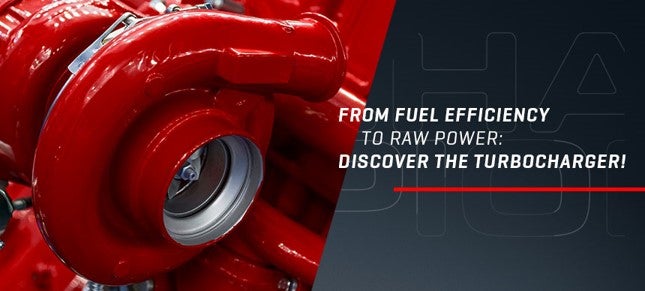Off to the fast lane, because we got turbocharged!

Release the full potential of your engine with turbochargers as multifunctional engine enhancers. A turbo is an application seen in a wide variety of vehicles, but how does a turbo enhance your engine?
Turbochargers redefined the look and soundscape of modern engines. Pushing down on your pedal will force you deeper into your seat, but an engine with a turbocharger will lift your driving experience to a higher level. You might expect large engines to benefit the most from turbo’s but a turbocharger also enables smaller engines to optimize their performance whilst obtaining better fuel efficiency.
Turbocharged
How does it work? Inside a combustion engine, an air-fuel mixture gets ignited. The turbocharger feeds additional air into your engine without consuming any energy. It does this by reusing the energy contained inside the exhaust gasses. These fast-moving gasses pass through the turbocharger where they rapidly spin a turbine. A second turbine connected to the one powered by the exhaust gasses sucks in air, compressing it far above the atmospheric pressure which normally would be used to supply the air intake.
The compressed air contains one of the essential elements for combustion: oxygen. By forcing a larger amount of oxygen into the cylinder, the injected amount of fuel can be increased. More fuel? That doesn’t sound fuel efficient! Well, the oxidation process inside the cylinder will be more efficient thanks to the dense air provided by the turbo. This increase in efficiency enables car manufacturers to decrease the size of the cylinder and engine block, resulting in an overall increase in fuel economy.
Turbocharger lexicon:
- Running rich: complete combustion without an excess of air or fuel.
- Running lean: combustion with an excess of air. The oxygen sensor regulates the intake and ensures that the optimal fuel-air combination is acquired.
Supercharger
Ill-informed rookies often mistake superchargers for turbochargers but when they are finished reading this blog they won’t ever make that mistake again!
Superchargers and turbochargers enable you to get more output from your engine, but they do this in different ways. The main difference is that a turbocharger recycles waste energy whilst a supercharger uses non-waste energy. A supercharger makes use of a turbine directly connected to the crankshaft, leading to a bit of drag.
But why do we still have superchargers? Are these outperforming turbochargers? No, the turbocharger’s turbine spins at higher RPM and it is capable of forcing more air into the cylinder without creating drag.
The main advantage of a supercharger lies in the weakness of a turbocharger: delay.
A supercharger kicks in directly after starting the engine, immediately sending compressed air into the combustion chamber. A turbocharger will gather kinetic energy over time and needs a few seconds to reach operational speed. This results in a few seconds of delay between pushing down on the accelerator and the surge of power flowing to the wheels.
Protect your turbocharger
A turbocharger is designed to spin fast, really fast… For instance, a well lubricated turbocharger can reach 300 000 RPM or more during full engine operation. This is why keeping a turbocharger well-lubricated is very essential, otherwise the heat generated inside will destroy your precious turbo. Whilst changing engine oil, you should always check its compatibility with your turbo. A great example of this is Champion’s OEM Specific 5W30 C4 engine oil if you drive a recent Renault Clio model. It is capable of protecting the turbo whilst maintaining excellent engine lubrication.
Champion’s product finder tool will assist you at finding a lubricant suitable for the whole of your engine, from crankshaft to turbocharger!
In short
- Turbochargers enable higher fuel efficiency.
- Turbochargers recycle waste energy whilst superchargers don’t.
- Good lubrication of a turbocharger is crucial.